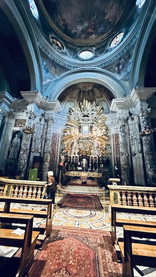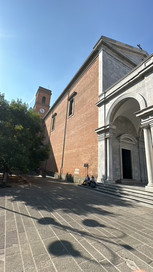Livorno Churches – Chiese di Livorno
- Maria Scuor
- Nov 11, 2024
- 8 min read
Italian under each section
On our trip to Livorno, we visited two Catholic churches. One a sanctuary and the other a cathedral. Both beautiful and rich in history.
Durante il nostro viaggio a Livorno, abbiamo visitato due chiese cattoliche. Uno un santuario e l'altro una cattedrale. Belle e ricche di storia.
Sanctuary of Our Lady of Montenero – Santuario Madonna di Montenero
Also known as the Sanctuary of Madonna della Grazie, this sanctuary is located high above Livorno and has an incredible view of the sea and port of Livorno. It dates back to May 15, 1345 when according to legend, a poor crippled shepherd found the miraculous image of the Virgin Mary. Following his intuition, he climbed the hill of Monte Nero, considered the “devil’s mountain” because it was dark, gloomy and a place where bandits hid. Once up the hill, the shepherd was cured of his illness.
In 1603, a small chapel called the Apparition was built in memory of this event. It was damaged after the Second World War therefore a bigger church was replaced the small chapel. Because of its fame, there were many pilgrimages over the years and the building got bigger and bigger by the tertiary friars, then the Jesuits and by the Theatines in the 17th and 18th century who expanded the sanctuary.
The sanctuary fell into ruin and was entrusted to the custody of the Vallombrosan monks, who restored it and in 1791, Ferdinand III donated the sanctuary in perpetuity to the Vallombrosan monks with permission to build an abbey there. On August 21, 1818 the sanctuary was elevated to rank of minor basilica by Pope Pius VII. On January 13, 1926, Pope Pius X granted the Mass proper that was approved years before in 1900. Tuscany declared the Madonna of Montenero its patron saint on May 15, 1947. It wasn’t until January 27, 2015, the church of Santa Maria delle Grazie was officially elevated to a Sanctuary.
Several buildings arranged around a rectangular square make up the sanctuary, with the main building being the church. There are several porticoes and a bell tower that dates back to 1820 which has a mechanical clock and sundial. There are three entrances to the nave of the baroque church. Near the main altar stands a tabernacle that contains the sacred image of the Madonna of Montenero.
In the transept, there are statues of San Giovanni Gualberto and San Bernardo that date back to the 19th century. The dome was beautifully frescoed by Florentine artist Giuliano Traballesi and features decorations by Giuseppe Maria Terreni. The 1965 pipe organ has three keyboards and a concave-radial pedalboard. The organ pipes are divided in two and are located in two transepts and controlled by a console located in the right gallery.
Behind the apse of the church there is the gallery of Municipalities. This is where there are coat of arms donated by the municipal councils of Tuscany after the proclamation of the Madonna of Montenero as the main patron saint of Tuscany. The Famedio is a portico that was to house the pilgrims’ dormitories but was never finished. It was enlarged and turned into a ‘Temple of Fame’ and houses the tombs of illustrious Livorno residents.
Finally, the Ex-Voto gallery, which as of 2024 holds over 14,000 items is situated along the sides of the church. To learn more about this amazing place that captured my whole being, read my PGR Per Grazie Recevuta - For Grace Received blog.
Santuario Madonna di Montenero
Conosciuto anche come Santuario della Madonna delle Grazie, questo santuario si trova in alto sopra Livorno e gode di un'incredibile vista sul mare e sul porto di Livorno. Risale al 15 maggio 1345 quando, secondo la leggenda, un povero pastore storpio trovò l'immagine miracolosa della Vergine Maria. Seguendo il suo intuito, salì sulla collina di Monte Nero, considerata la "montagna del diavolo" perché buia, cupa e luogo dove si nascondevano i banditi. Una volta su per la collina, il pastore fu guarito dalla sua malattia.
Nel 1603 fu costruita una piccola cappella chiamata l'Apparizione in memoria di questo evento. Fu danneggiata dopo la seconda guerra mondiale, quindi una chiesa più grande fu sostituita dalla piccola cappella. A causa della sua fama, nel corso degli anni ci furono molti pellegrinaggi e l'edificio fu sempre più grande ad opera dei frati terziari, poi dei Gesuiti e dei Teatini nel XVII e XVIII secolo che ampliarono il santuario.
Il santuario cadde in rovina e fu affidato alla custodia dei monaci vallombrosani, che lo restaurarono e nel 1791, Ferdinando III donò il santuario in perpetuo ai monaci vallombrosani con il permesso di costruirvi un'abbazia. Il 21 agosto 1818 il santuario fu elevato al rango di basilica minore da papa Pio VII. Il 13 gennaio 1926 papa Pio X concesse la messa vera e propria che era stata approvata anni prima, nel 1900. La Toscana dichiarò la Madonna di Montenero sua patrona il 15 maggio 1947. Solo il 27 gennaio 2015 la chiesa di Santa Maria delle Grazie è stata ufficialmente elevata a Santuario.
Diversi edifici disposti intorno a una piazza rettangolare compongono il santuario, con l'edificio principale che è la chiesa. Ci sono diversi portici e un campanile che risale al 1820 che ha un orologio meccanico e una meridiana. Ci sono tre ingressi alla navata della chiesa barocca. Vicino all'altare maggiore si trova un tabernacolo che contiene l'immagine sacra della Madonna di Montenero.
Nel transetto si trovano le statue di San Giovanni Gualberto e San Bernardo che risalgono al XIX secolo. La cupola è stata splendidamente affrescata dall'artista fiorentino Giuliano Traballesi e presenta decorazioni di Giuseppe Maria Terreni. L'organo a canne del 1965 ha tre tastiere e una pedaliera concava-radiale. Le canne d'organo sono divise in due e si trovano in due transetti e sono comandate da una consolle posta nella galleria destra.
Dietro l'abside della chiesa si trova la galleria dei Comuni. È qui che si trovano gli stemmi donati dai consigli comunali della Toscana dopo la proclamazione della Madonna di Montenero come patrona principale della Toscana. Il Famedio è un portico che doveva ospitare i dormitori dei pellegrini ma che però non fu mai terminato. Fu ampliato e trasformato in 'Tempio della Fama' e ospita le tombe di illustri livornesi.
Infine, la galleria degli Ex-Voto, che a partire dal 2024 contiene oltre 14.000 pezzi, si trova lungo i lati della chiesa. Per saperne di più su questo luogo incredibile che ha catturato tutto il mio essere, leggete il mio blog PGR Per Grazie Recevuta - For Grace Received.
Livorno Cathedral – Duomo di Livorno
The cathedral of Livorno named after St. Francis was commissioned in the 16th century by the powerful Italian noble family the Medicis. Designed by Bernardo Buontalenti in the second half of 16th century, however Ferdinando I de’Medici wanted significant changes therefore the work didn’t begin until 1594 under the direction of Alessandro Pieroni. Alessandro abandoned Bernardo’s project and increased the dimensions of the church, added a loggia and porticoes.
Work proceeded rapidly, by 1596 the façade was erected but didn’t have the marble cladding, by 1599 the bell tower was completed and the church was consecrated, dedicated to Santa Maria, San Francesco and Santa Giulia, in 1606. The church was enlarged with the addition of two side chapels which changed the plan from rectangular to Latin Cross plan.
Many more renovations took place over the centuries however the air raids of 1943 – 1944 destroyed most of the cathedral. Only the perimeter wall on the right, the area of the choir stalls, the altar of the Blessed Sacrament, the chapel of the Baptistery and several works of art that had been placed in safety, were saved. With Piazza Grande having been destroyed as well very little of the original layout of the square was retained.
The Cathedral was rebuilt, however because economical reasons many components were not rebuilt. An exedra was placed behind the apse, as well as porticoes were added on the two arms of the transept. 5 bronze bells were installed in the bell tower, which were obtained by melting the bells recovered from the ruins and with the bronze of a bell donated by the archconfraternity of Purification. Even though the cathedral wasn’t completed, it was consecrated on December 20, 1953.
The external building is covered with brick and has a gabled marble façade, with a loggia that has three round arches. The main entrance has a massive door that was sculpted by Antonio Vinciguerra. The façade where the baptistery sits, was left in tact and has a stone facing with a triangular tympanum at the top. The rear facing of the church has a large exedra, where the apse is located. The rebuilt bell tower stands 50 m high and has a clock on it.
It interior is Latin cross with a single nave with two side chapels: the left one of the Santissimo Sacramento and the one on the right of the Conception of Maria which leads to the baptistery. The baptismal font dates back to the 17th century and sits in the Baptistery chapel. The original gilded wood ceiling was destroyed however the seven paintings were saved and reinserted into a similar structure. The organ built in 1961 has an electric transmission, is divided into 44 registers and has three distinct bodies. The console has three keyboards with 61 notes each and a concaved-radial pedalboard of 32 notes.
Duomo di Livorno
Il duomo di Livorno intitolata a San Francesco fu commissionata nel XVI secolo dalla potente famiglia nobile italiana dei Medici. Progettato da Bernardo Buontalenti nella seconda metà del XVI secolo, tuttavia Ferdinando I de' Medici volle notevoli modifiche e i lavori iniziarono solo nel 1594 sotto la direzione di Alessandro Pieroni. Alessandro abbandonò il progetto di Bernardo e aumentò le dimensioni della chiesa, aggiungendo una loggia e portici.
I lavori procedettero spediti, nel 1596 fu eretta la facciata ma non aveva il rivestimento marmoreo, nel 1599 fu completato il campanile e fu consacrata la chiesa, dedicata a Santa Maria, San Francesco e Santa Giulia, nel 1606. La chiesa fu ampliata con l'aggiunta di due cappelle laterali che cambiarono la pianta da rettangolare a pianta a croce latina.
Molte altre ristrutturazioni hanno avuto luogo nel corso dei secoli, tuttavia i bombardamenti aerei del 1943-1944 hanno distrutto la maggior parte della cattedrale. Si sono salvati solo il muro perimetrale di destra, l'area degli stalli del coro, l'altare del Santissimo Sacramento, la cappella del Battistero e diverse opere d'arte che erano state poste in sicurezza. Con la distruzione di Piazza Grande, ben poco dell'impianto originario della piazza è stato conservato.
La Cattedrale è stata ricostruita, tuttavia, per motivi economici molti componenti non sono stati ricostruiti. Dietro l'abside fu collocata un'esedra e furono aggiunti portici sui due bracci del transetto. Nel campanile sono state installate 5 campane in bronzo, ottenute dalla fusione delle campane recuperate dai ruderi e con il bronzo di una campana donata dall'arciconfraternita della Purificazione. Anche se la cattedrale non fu completata, fu consacrata il 20 dicembre 1953.
L'edificio esterno è rivestito in mattoni e presenta una facciata marmorea a capanna, con una loggia che presenta tre archi a tutto sesto. L'ingresso principale ha un massiccio portone che è stato scolpito da Antonio Vinciguerra. La facciata, dove si trova il battistero, è stata lasciata intatta e presenta un rivestimento in pietra con un timpano triangolare alla sommità. La parte posteriore della chiesa presenta una grande esedra, dove si trova l'abside. Il campanile ricostruito è alto 50 m e ha un orologio.
L'interno è a croce latina a navata unica con due cappelle laterali: quella sinistra del Santissimo Sacramento e quella a destra della Concezione di Maria da cui si accede al battistero. Il fonte battesimale risale al XVII secolo e si trova nella cappella del Battistero. L'originale soffitto in legno dorato è andato distrutto, ma i sette dipinti sono stati salvati e reinseriti in una struttura simile. L'organo costruito nel 1961 ha una trasmissione elettrica, è suddiviso in 44 registri e ha tre corpi distinti. La consolle ha tre tastiere con 61 note ciascuna e una pedaliera concava-radiale di 32 note.














































































































Comments